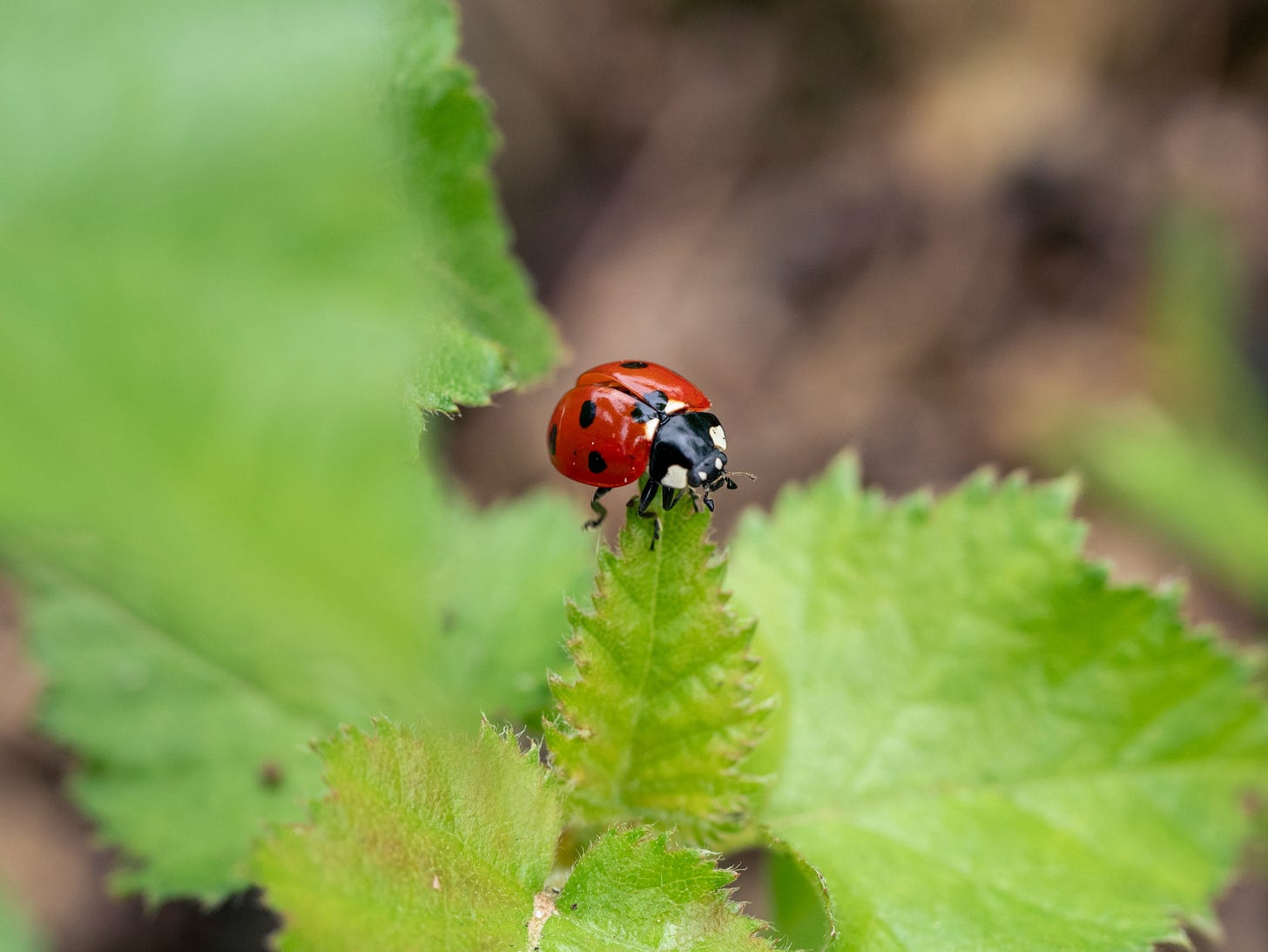
I’m officially obsessed with ladybirds, as those of you who follow my notes will know.
Ladybirds, or ‘ladybugs’ for my American readers, just make me happy! In the winter, they are a cheerful pop of colour amid dull, muddy browns, and in the spring, popping up everywhere, a fabulous focal point for any nature photograph.
In many cultures seeing or catching a ladybird is considered good luck. As a child, it was fun to count the spots and find out how many years of good luck you could expect to receive. As an adult, I still find it fun, only now I’m figuring out which species I’m looking at. My inner child did feel a flurry of excitement when a ladybird landed on me a few days ago though - surely that’s extra good luck??

I also associate these pretty little insects with joy, thanks to my reading habits as a child. An avid reader, it was the Ladybird collection of books that gave me my first introduction to fairy tales, shaping the adult I was to become (writing fantasy and magical realism as a hobby).
The ladybird is an iconic symbol and if my notes are anything to go by, brings a smile to most people’s faces when they see one. And so, I thought it was high time I learnt a little more about them..
There are a few theories as to how ladybirds got their name; according to National Geographic:-
The name "ladybug" was coined by European farmers who prayed to the Virgin Mary when pests began eating their crops. After ladybugs came and wiped out the invading insects, the farmers named them "beetle of Our Lady." This eventually was shortened to "lady beetle" and "ladybug."
Love the Garden has a slightly different version of the Virgin Mary theory:-
The collective name for ladybirds is the Coccinellidae, which has its origins in the Latin word coccineus meaning ‘scarlet’.
The word ‘Ladybird’ is thought to have been inspired by early images of the Virgin Mary who would appear wearing a red cloak.
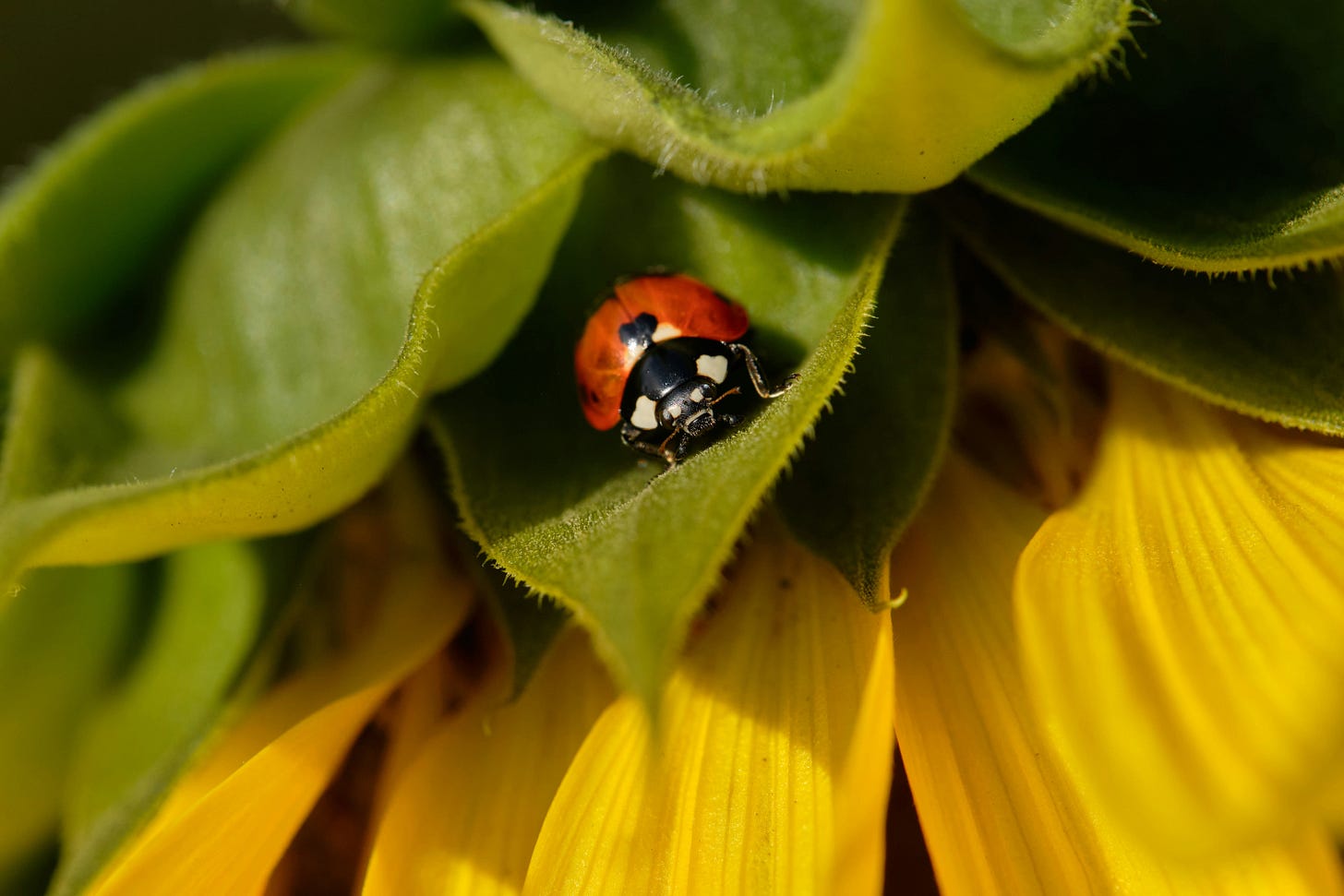
Ladybird spotting has become a new hobby of mine. In winter, I found a cluster of these gorgeous creatures huddled together on the top of a hazel stem. Excited at this unexpected find, I took a few photographs, then returned to my walk. As my daily dog walk is circular, I soon passed by them again. They didn’t appear to have moved, this struck alarm bells and I peered closer to check on them. No, they definitely weren’t moving..
I confess, I poked gently at one of them, which promptly fell off the branch and into the leaf litter below, looking devoid of life. I was horrified. Had I just joyfully taken a photo of a group of dead ladybirds? Devasted, I quickly deleted it from my phone, and returned to my walk, my head hanging in shame.
For the rest of the day, I carried around a nagging sense of guilt, and sadness at the thought of these poor creatures, huddling together for warmth, and then freezing in our recent minus zero temperatures. How selfish of me to be photographing sparkling hoar frosts when there were creatures freezing to death.
But then a thought struck me. What if they weren’t actually dead? Did ladybirds hibernate? I googled it, and my happiness returned (as did the photos, retrieved from my phone’s archive) when I discovered that YES, they do!
Ladybirds ‘overwinter’ (also known as diapause) from October through to February. Prompted by the disappearance of aphids, they survive on their fat reserves until spring. They look for sheltered, warm, secluded places (I’m not entirely sure the top of my hazel stem counts?) and often hibernate together in large groups. Sometimes hibernating colonies can contain thousands of ladybirds. Wouldn’t that be a sight?
It was such a relief to know that I hadn’t discovered frozen ladybird corpses, and they were simply huddled together to hibernate for the winter, likely to wake in the spring to continue with their business. Unfortunately, one of them might wonder why they are on the floor instead of on the tip of a hazel branch where they went to sleep… I’m sorry about that.
Their choice of cosy places to hibernate sometimes include houses. If you do find a ladybird inside your home, it should ideally be moved to a sheltered spot outside to ensure that they complete their overwintering.
We are currently renovating one of our upstairs rooms, and as spring began to bathe the room in sunlight, heating up the walls, a handful of ladybirds emerged from their winter slumber. A day’s work for Andrew in March often began with a ladybird rescue of some kind.
As the temperatures began to rise, and we had a few rays of sunshine, I spotted my first active ladybird climbing the fence of my veg plot. Then, as March got into full swing, ladybird spotting became a daily activity. They seemed to have a few favourite hang outs; the daffodils at the bottom of the rowan tree, a patch of purple dead nettle, the hazel hedge.
On my mission to photograph something beautiful in nature each day, I found them in many unexpected places. Nestled in a patch of violets, climbing the door of my greenhouse, scrambling unconcerned across a terrifyingly spiky nettle, and my personal favourite:-
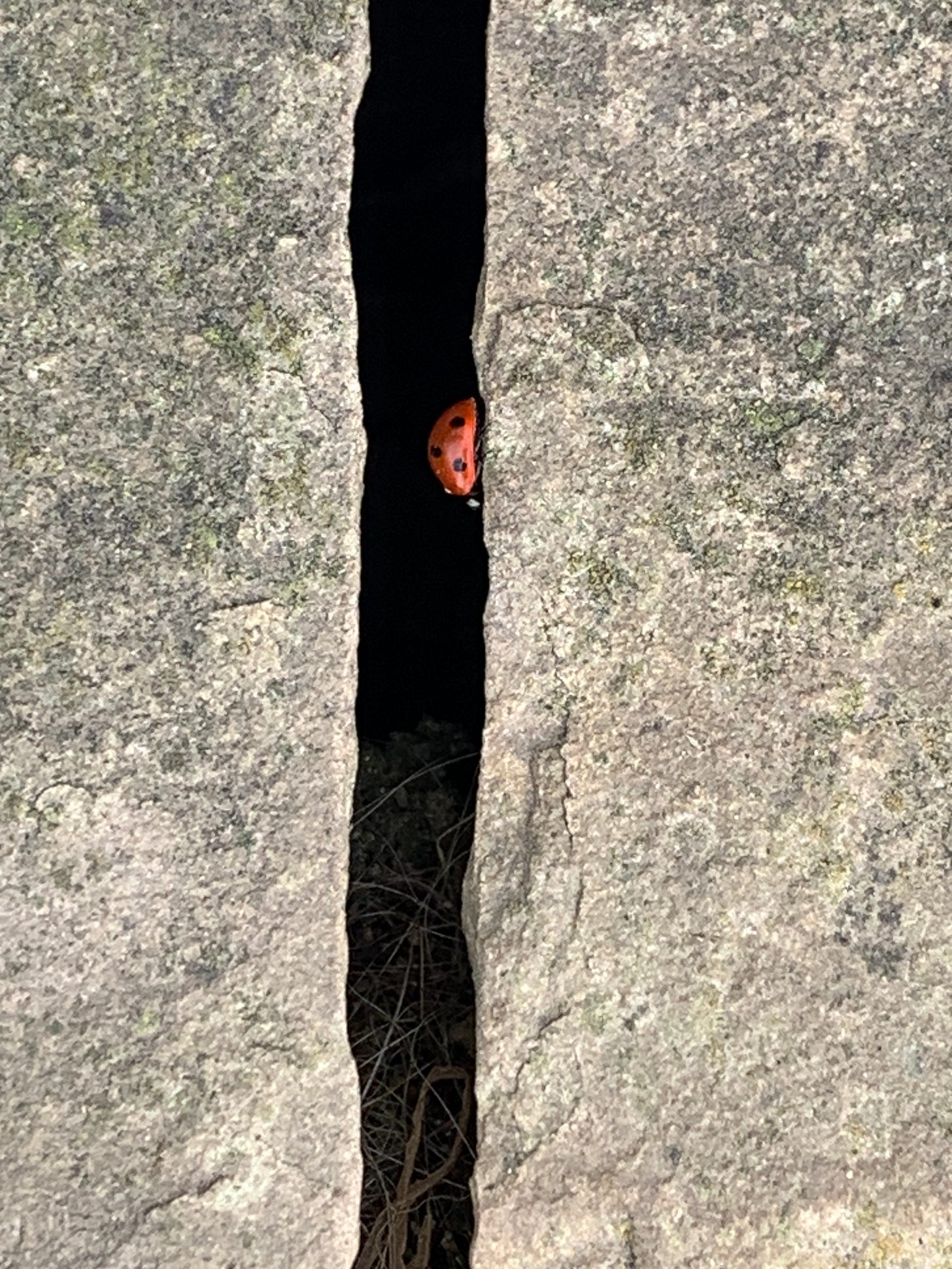
There are believed to be 26 different ladybird species in the UK, the most common being the 7 spot ladybird. Some ladybirds are specific to a type of plant or tree, like the Pine Ladybird. The Harlequin Ladybird is an invasive non native species that feeds on the eggs and larvae of other ladybirds and can be distinguished from others by its brown legs.
I was surprised to learn that ladybirds are not always red, they can also be yellow, orange, or brown/black and they can have red, black or even white spots! I particularly like the look of the Orange Ladybird. This particular species is associated with ancient woodland but can be found amongst sycamore and ash trees. Definitely one for the life list:-
Another reason ladybirds make people smile, is that they are considered beneficial insects. Popular with farmers and gardeners, they are a natural alternative to spraying with chemicals. They eat insects that are harmful to plants and crops such as aphids, mealybugs, mites, thrips and scale insects. In fact, just one ladybird can eat up to 50 aphids a day and 5,000 insects in its lifetime!
For some reason, it always comes as a genuine surprise to me, that ladybirds can fly. I gasp in surprise when, for the first time in the year, I see one lift its hard shell, revealing a pair of transparent wings and take off like a helicopter into the sky.
Ladybirds mostly fly during the day and may migrate long distances to hibernation and breeding sites. Studies have revealed that they can fly as far as 75 miles, at speeds of 19 mph, and could reach altitudes close to 3,600 ft. These insects have even been to space! As NASA sent a few ladybugs into space with aphids to see how aphids would escape in zero gravity.
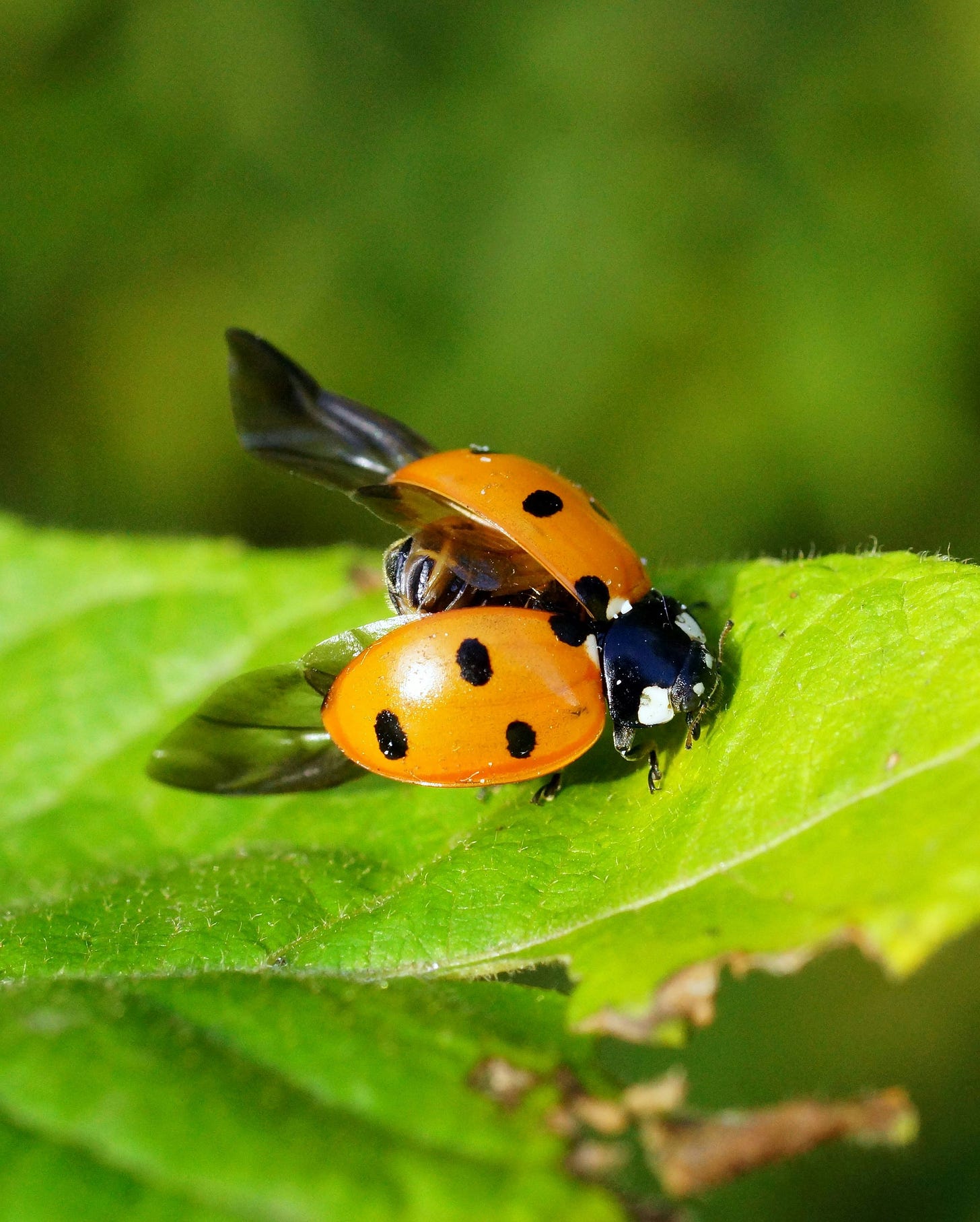
Whilst the ability to fly is one way they might escape their predators, ladybirds also have other methods, including a secret hidden weapon. They are colourful for a reason, to deter predators from eating them. Their markings warn predators that if they do, they’ll taste pretty terrible. They can play dead, and when threatened they secrete a yellow, foul-tasting fluid from joints in their legs. This liquid is toxic to many of their predators, which include birds and small mammals. Ladybirds also fall prey to frogs, wasps, spiders and dragonflies. No wonder they need so many tools in their arsenal!
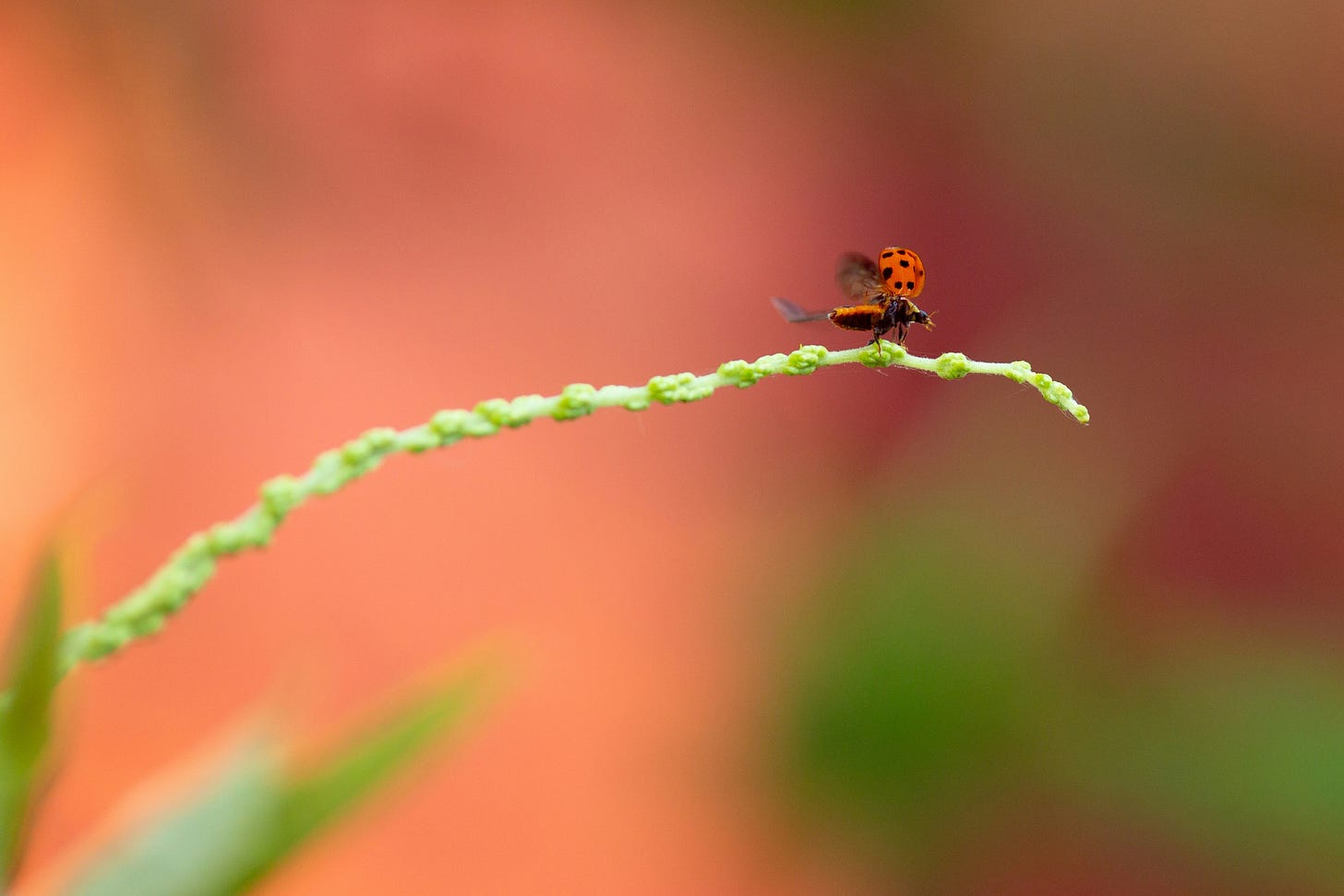
Amazingly, a ladybird can live between 1 and 3 years, so even longer than the wood mouse or the pheasant.
Despite its association with luck and its attractive appearance, the ladybird has a bit of a sinister side as cannibalism has been recorded in several species. According to TreeHugger.com:-
Female ladybugs lay as many as 1,000 tiny gold-coloured eggs during a single season, but not all of the eggs make it to adulthood. While they prefer to lay their eggs on leaves covered with aphids, when prey is in short supply, the ladybugs may eat the eggs and larvae.
In fact, ladybugs plan ahead for supply shortages; when food is scarce, ladybugs lay infertile eggs to provide for their offspring
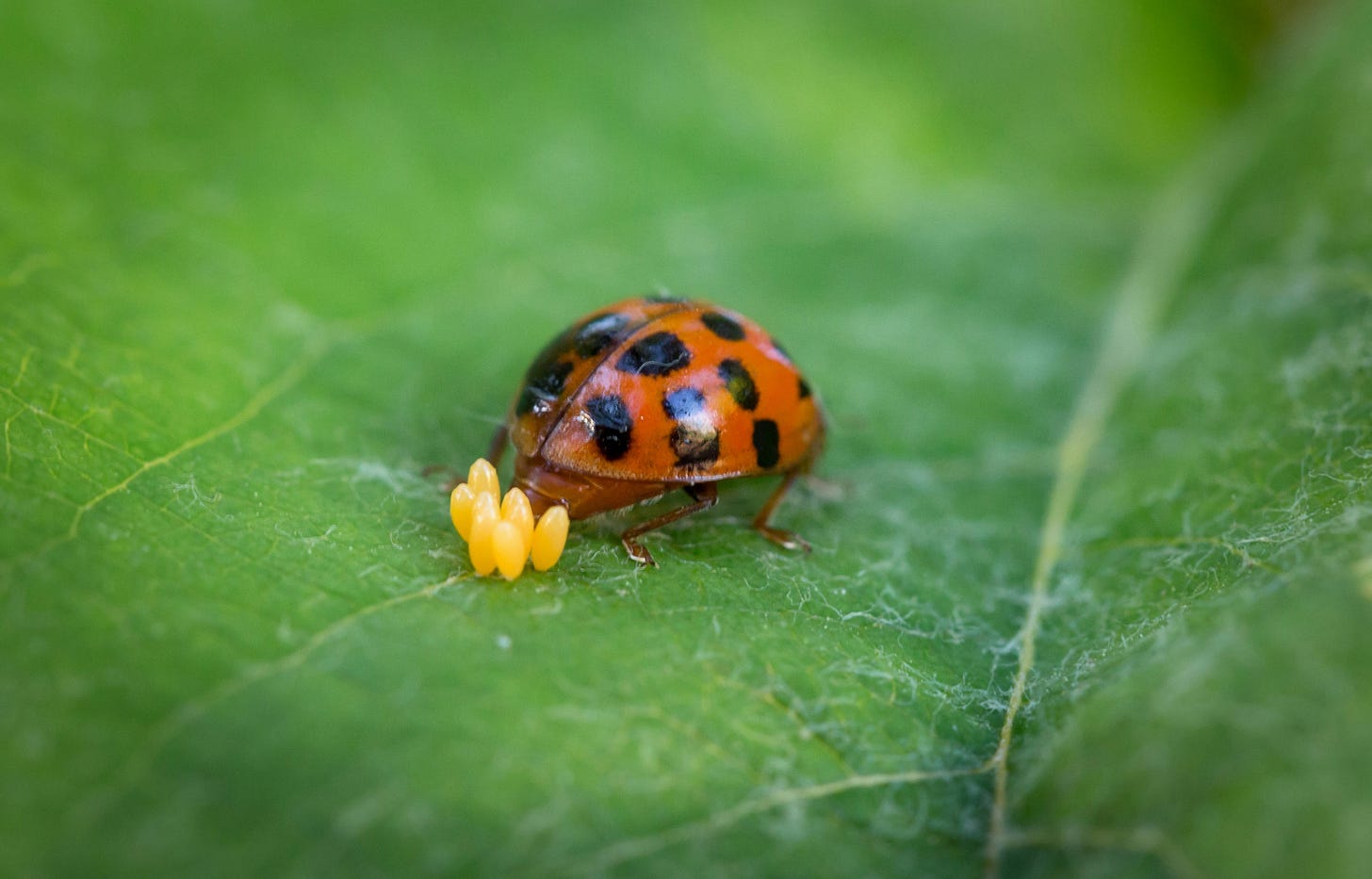
However, this doesn’t put me off this graceful and charming little insect, and I will still be out with my camera every day looking for more photo opportunities.
Sadly however, ladybirds are declining in number.
Researchers studying a decline in native ladybugs in the United States and Canada theorize that the population reduction may be due to the introduction of non-native species, climate change, land-use changes, disease, or shifts in the availability of prey.
If you would like to encourage more of these creatures to your space, you can create a simple ladybird hotel by binding together a few pinecones and placing them in a sheltered spot in your garden. Nettles are a firm favourite for egg laying, so leaving a few patches would be greatly appreciated by these helpful insects. Also avoiding spraying pesticides is greatly beneficial.
If you would like to plant some flowers that help to attract ladybirds, you could try any of the following:- yarrow, angelica, fennel and dill, calendula, sweet alyssum and marigolds.
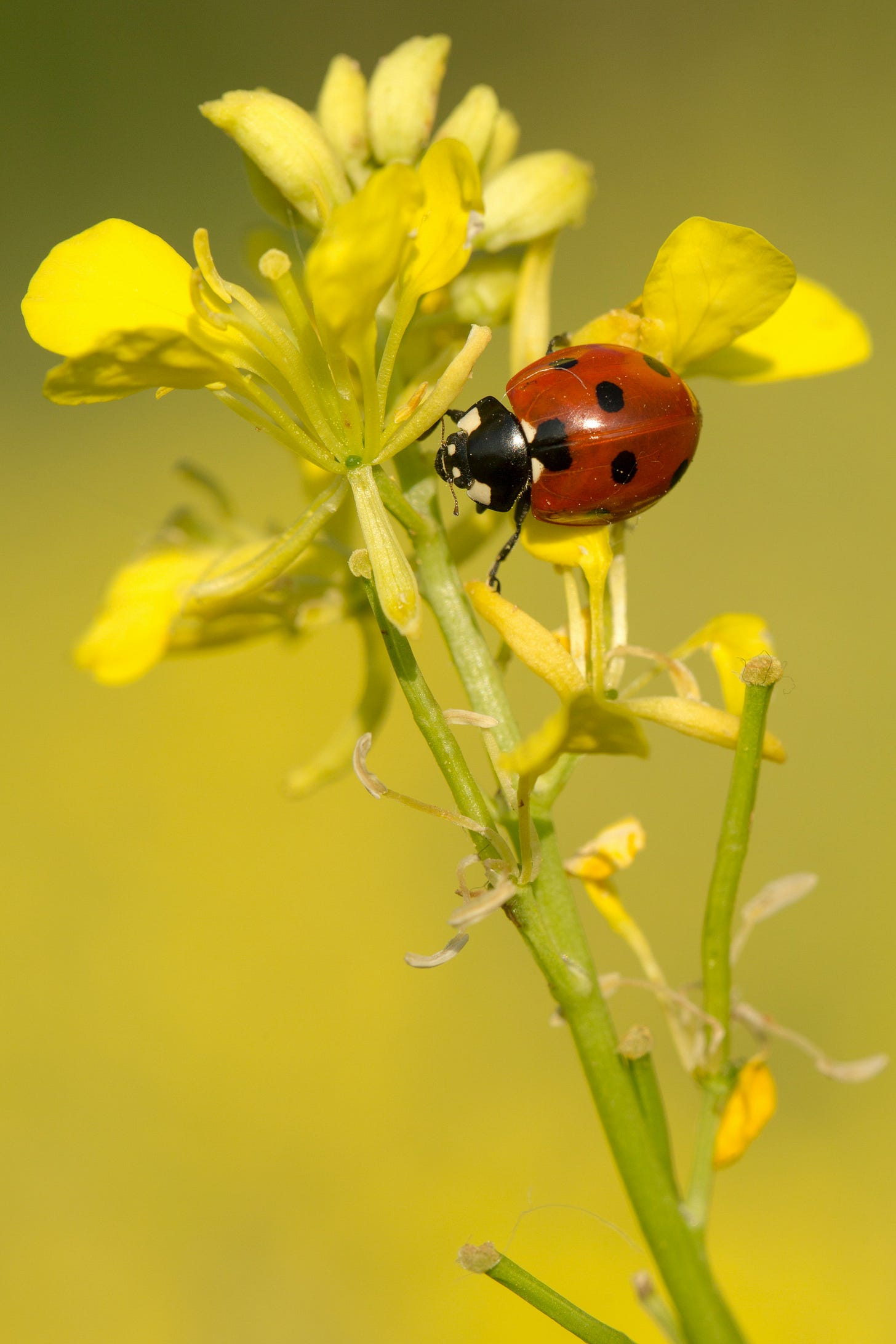
I would love to hear about your experiences with ladybirds in the comments, and photos are always very welcome, please tag me in your notes if you decide to share any ladybird pics! Do ladybirds make YOU happy?
There are a couple of projects helping to track ladybirds, if you are interested details can be found here:-
INFORMATION SOURCES








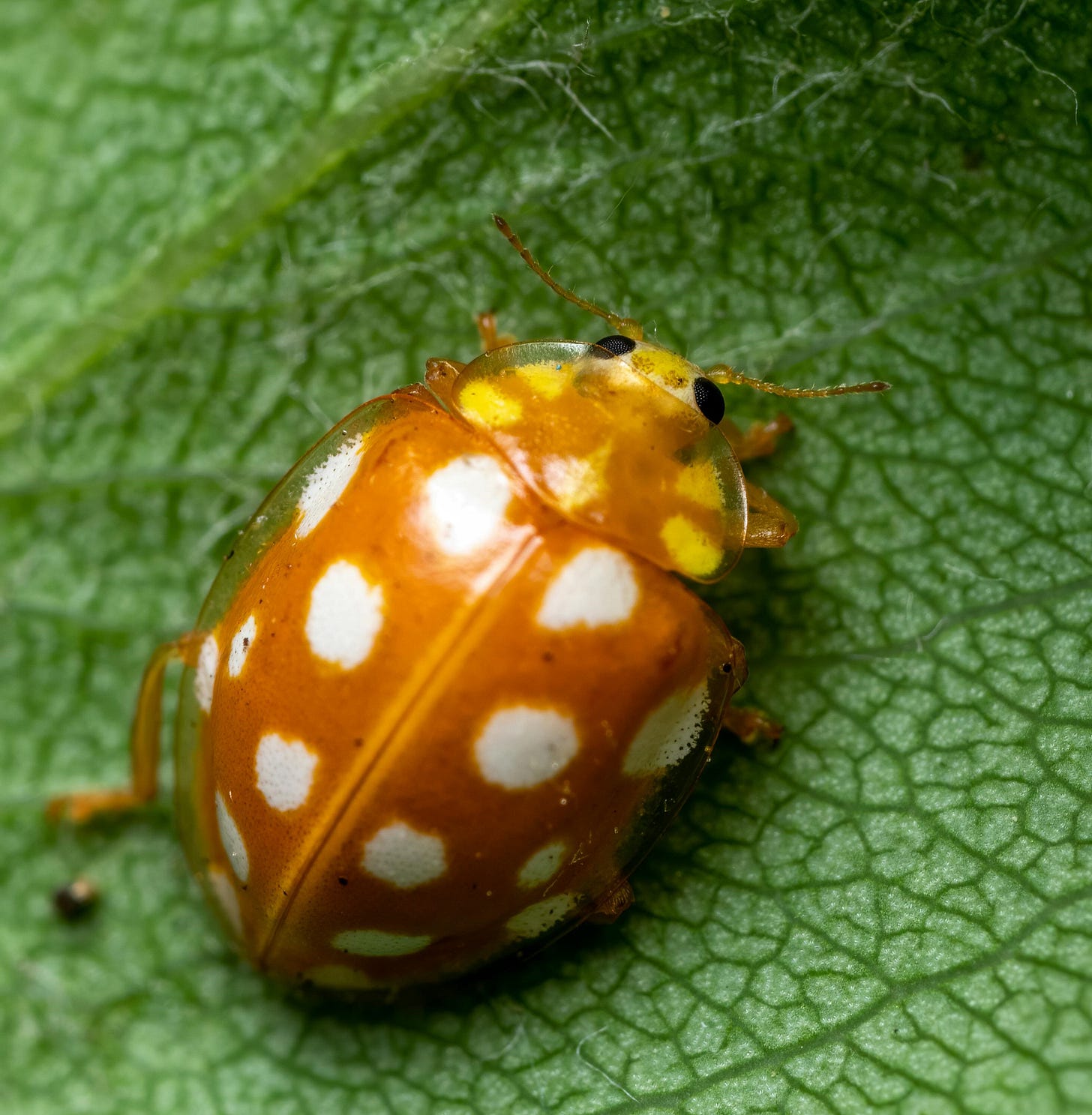

Very interesting and informative article, Melissa.
I also love ladybirds, and do everything I can to attract them to my garden. I can confirm that they like marigolds and dill, and I always seem to get lots of larvae on sunflowers.
Any I find in autumn I put in plant containers that are not going to be disturbed over the winter, and they seem to survive just fine.
As well as being very cute they are fantastic for controlling aphids, because both the larvae and the adults feed on these. SO much better than using bug sprays!
What a great project. I have always been fascinated by these amazing creatures. Love the information and the pictures. One of my ladybird pictures was used by Fuji in an exhibition.
I still remember the feeling of awe at seeing the tracks made by two ladybirds as they munched their way through an infestation of aphids.
Thank you for brightening my day